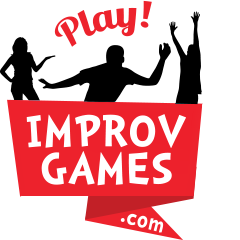Quick Description
In the Carousel, the players line up. Player one steps forward and creates a repeatable movement and repeats it continually. Player two steps forward and copies the movement exactly. Player two says a line of dialogue that identifies what they are both doing. Round over. Player one steps back into line. The pattern is repeated with Player two creates a different repeatable movement.
How to Play
The first player in line steps forward, faces the line and create a repeatable abstract motion. Give it a little time to settle in. When they have it set, the next person in line (player two) steps forward and imitates that motion exactly.
When the second person (player two) feels that have the motion exactly like the first player, they make an affirmative statement, that is as specific as possible about what’s going on in the real world based on the abstract motion.
The first players agrees with the affirmative statement and adds more detail.
That exchange ends the activity.
Round two: Player one steps back into line with the other players. Player two steps into the Player One spot and immediately begins a repeatable abstract movement.
Player three steps forward and repeats the process of imitating the motion and then adding an affirmative statement.
It’s called the Carousel because it cycles around the players like a carousel.
“Characterization must begin at home, in the body. Some of us are not at home in our bodies. We must discover what that means. Therefore the main emphasis of my work is physical self discovery.”
– Carlo Mazzone-Clementi
Notes
This is not a guessing game where player two has to guess what Player 1 is doing. It’s about being spontaneous with your body and then letting your beautiful brain discover what is happening.
There are many things you can focus on as a teacher with this activity
- Physicality and presence. Take your time to imitate the motion exactly from the feet to the head. Indulge in the feeling of the motion.
- Yes And. Practice making affirmative statements that include your partner not fight with them. And adding something affirmative and inclusive.
- Specificity. A great way to practice being specific. Name names, places, emotions, everything.
- Simplicity. Keep it simple. Resist the temptation to be clever, funny or obscure. Practice taking the first thing your brain gives you. Be obvious.
- Physical elements: You can ask the group to add variety in their movements.
Variations
This activity could be played in pairs or smaller groups.
It shares similarities to an activity I call The Laura Derry Scene Start. I should write that one up.
Origin
This activity comes to us from Jeff Raz. He learned it from Carlo Manzoni-Clementi
Get the The Playbook so you have hundreds of games in your pocket when you need them.
